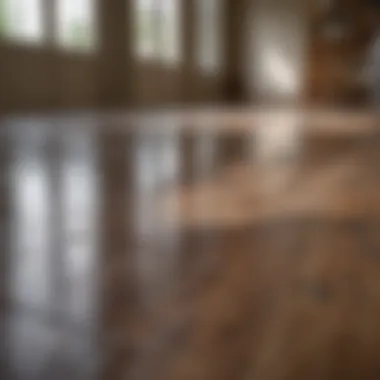Effective Strategies for Cleaning Laminate Floors with Ammonia


Intro
Cleaning laminate floors can often seem complex, especially when choosing the right products and methods. Among these choices, ammonia emerges as a popular solution. This guide will break down its effectiveness, potential benefits, and any safety precautions you should be aware of. Understanding how to properly use ammonia will not only help maintain the pristine condition of your flooring but also elevate the overall appearance of your living space.
The aim is to demystify this cleaning process. You will learn the most efficient dilution ratios, step-by-step cleaning procedures, and discover alternative solutions when ammonia does not seem suitable. Safety measures will also be discussed to ensure that your cleaning routine is both effective and secure.
Understanding Laminate Flooring
Understanding laminate flooring is essential in fostering informed decisions about cleaning and maintaining these surfaces. Laminate flooring simulates the appearance of wood, stone, or other materials while offering unique benefits. Knowing the structure and features of laminate can prevent damage during cleaning and ensure longevity.
What is Laminate Flooring?
Laminate flooring consists of multiple layers. It generally has a core layer made from high-density fiberboard or particle board. Over this core, a photographic layer presents the design, which mimics natural materials. Above this, a clear protective layer guards against scratches and wear. Because of its composition, laminate is known for being durable and cost-effective compared to hardwood or ceramic options.
Benefits of Laminate Flooring
Laminate flooring offers various advantages:
- Cost-Effective: It is typically less expensive than hardwood, making it an attractive option for budget-conscious homeowners.
- Durability: The protective layer helps resist scratches and stains, contributing to its long lifespan.
- Easy Installation: Many laminate products use a tongue-and-groove system, allowing for straightforward DIY installation.
- Variety of Designs: The photographic layer allows for a wide range of designs, giving flexibility to match any decor.
- Low Maintenance: Regular cleaning, often just with a broom or a damp mop, suffices for upkeep, making it suitable for busy households.
Common Types of Laminate Flooring
Different types of laminate flooring are available, appealing to a range of styles and preferences:
- High Gloss Laminate: This type has a shiny surface which can brighten a space, though it may show scratches more easily.
- Textured Laminate: Mimics the feel of real wood or stone, providing a more authentic appearance.
- Water-Resistant Laminate: Designed for areas with moisture, like kitchens or bathrooms.
- Wide Plank Laminate: Features broader boards that create a spacious look, suitable for larger areas.
Each type presents unique characteristics which play an important role when selecting a cleaning method, especially when using strong agents such as ammonia. Knowing these details helps homeowners maintain their floors while maximizing the investment in their living spaces.
Cleaning and Maintenance of Laminate Floors
Cleaning and maintaining laminate floors is essential for preserving their appearance and durability. Laminate flooring, while known for its resilience and aesthetic appeal, requires regular attention to maintain its shine and prevent long-term damage. Understanding the cleaning process is not just about aesthetics; it plays a critical role in sustaining the integrity of the flooring.
Proper cleaning helps to remove dirt, dust, and debris that accumulate over time. If ignored, these particles can scratch the surface, leading to irreversible damage. Regular maintenance will prolong the life of the flooring, making it a cost-effective choice for homeowners. Each cleanup restores the laminate's glossy finish, brightening the living space.
The Importance of Regular Cleaning
Regular cleaning maintains the beauty and functionality of laminate floors. Dust and grime act like sandpaper, eroding the surface over time. Therefore, a consistent cleaning routine is crucial. This involves simple steps, such as sweeping and mopping, using suitable cleaning solutions that do not harm the laminate material.
Incorporating regular cleaning into your routine offers multiple benefits:
- Enhanced appearance: Clean floors give a welcoming feel to the home.
- Preventive care: Regular cleaning prevents dirt buildup and maintains the flooring finish.
- Easier upkeep: Consistent care minimizes the time and effort needed for deeper cleaning sessions.
Adopting a regular cleaning schedule can significantly impact the floor's longevity. Many homeowners often overlook this aspect, thinking it is unnecessary. However, it is the foundation of preserving your laminate investment.
Common Cleaning Challenges
Despite its advantages, cleaning laminate floors comes with a set of challenges. Understanding these obstacles is crucial for effective maintenance. One common difficulty is maintaining moisture levels. Laminate does not respond well to excess water, which can lead to warping. Therefore, using damp cleaning methods is vital.
Another issue relates to stain management. Stains from spills can be stubborn, and applying the wrong cleaning solution may make things worse. It is essential to identify the type of stain and choose an appropriate method for removal without sacrificing the flooring’s integrity.
Furthermore, certain cleaning tools can also pose a problem. For instance, using abrasive materials can scratch and dull the laminate surface. Homeowners should use soft cloths or mops designed for laminate.


Ammonia as a Cleaning Agent
Ammonia has gained recognition as a versatile and effective cleaning agent. This section examines its significance in the realm of cleaning laminate floors, particularly emphasizing its properties, advantages, and considerations when using it. Understanding these key elements can enhance your ability to maintain and care for laminate flooring effectively.
Properties of Ammonia
Ammonia is a colorless gas with a distinct pungent odor, often found in household cleaning products. It is known chemically as NH₃ and possesses several characteristics that make it beneficial for cleaning purposes:
- Alkalinity: Ammonia is alkaline in nature, which aids in breaking down grease and grime on various surfaces. This property makes it particularly effective against sticky residues often found on floors.
- Dissolving Capability: Ammonia has the ability to dissolve certain kinds of stains and dirt, making it a useful agent for removing complex blemishes without heavy scrubbing.
- Volatility: Being volatile allows ammonia to evaporate more quickly than water, which can help in minimizing residue left after cleaning.
However, it is essential to recognize that ammonia can be harsh. It can cause irritation to the skin, eyes, and respiratory system if not handled properly. Hence, taking appropriate safety precautions is crucial.
Effectiveness of Ammonia on Stains
When it comes to removing stains from laminate floors, ammonia can be particularly effective:
- Oil and Grease Stains: The chemical reaction between ammonia and greasy substances helps to break them down, making it easier to wipe away tough stains that would otherwise remain.
- Food and Beverage Stains: Ammonia can also tackle common spill incidents— from coffee to juice—by breaking down the remnants and discoloration associated with such materials.
- Fast Acting: Many users report that ammonia acts quickly, significantly reducing the time needed for cleaning tasks. This efficiency is beneficial for those with busy lifestyles.
"Utilizing ammonia not only eliminates the need for hard scrubbing but also enhances the longevity of laminate surfaces through proper care."
In summary, the integration of ammonia into your cleaning routine offers a straightforward solution for maintaining the appearance of laminate floors. As with any cleaning agent, knowledge of its properties and effectiveness can lead to better cleaning outcomes.
Preparing Your Cleaning Solution
Preparing the right cleaning solution is essential when it comes to maintaining laminate floors with ammonia. The efficacy of the cleaning process significantly relies on the proper formulation of the solution. A well-prepared mixture can effectively remove stains and grime without harming the delicate surface of laminate flooring. Conversely, using an incorrect dilution can lead to ineffective cleaning or even damage.
Key Benefits of a Properly Prepared Solution:
- Effective Cleaning: Correct dilution helps to maximize the cleaning power of ammonia while minimizing harshness.
- Safety Assurance: A properly mixed solution is less likely to cause unintended damage to the laminate or surroundings.
- Cost Efficiency: Using the right concentration prevents wastage of ammonia, making the cleaning process more economical in the long run.
In preparing the solution, it is important to consider the specific needs of the floor's condition and any particular stains that may need extra attention.
Recommended Dilution Ratios
Understanding the recommended dilution ratios for ammonia is crucial. For most cleaning purposes, a standard ratio is about 1 cup of ammonia to 1 gallon of water. This dilution is effective for general cleaning and maintains the integrity of the laminate flooring.
If the floor has stubborn stains, a stronger solution may be necessary. A common method is to increase the ammonia to 1.5 cups per gallon of water. However, caution is advised to avoid using excessive ammonia which can lead to residue.
Materials Needed for Cleaning
To successfully clean laminate flooring using ammonia, specific materials are required. This ensures a comprehensive approach and enhances the cleaning process. Here is a brief list of what you need:
- Ammonia: Make sure to select clear ammonia for cleaning.
- Measuring Cup: For accurate measurement of ammonia.
- Bucket: A large container to mix your solution.
- Mop: A microfiber mop is recommended as it collects dust and dirt efficiently without scratching surfaces.
- Clean Cloths: Soft, absorbent cloths help in wiping without leaving streaks.
- Rubber Gloves: Protect your hands while handling ammonia.
- Protective Mask: To avoid inhaling fumes, especially in less ventilated areas.
Having these materials ready will streamline the cleaning process and ensure you are set for an effective cleanup.
Step-by-Step Cleaning Process
The step-by-step cleaning process is crucial for effectively maintaining laminate floors. Following a systematic approach not only ensures the best cleaning results but also helps prevent damage to the flooring surface. Each stage of the process addresses specific tasks and preparations necessary to maximize the effectiveness of ammonia as a cleaning agent. Homeowners can feel secure knowing they are safeguarding their investment while enjoying a pristine living space.
Pre-Cleaning Preparations
Before starting the cleaning process, certain pre-cleaning preparations are essential. Initially, clear the area of any furniture or large items. This step allows you to access the entire floor surface without obstruction. Next, sweep or vacuum the floor to remove dust, dirt, and debris that could scratch the laminate during cleaning.


Ensure you have all necessary materials at hand. This includes:
- A bucket for mixing the ammonia solution.
- A mop or microfiber cloth for application.
- Gloves to protect your hands from direct contact with ammonia.
- Adequate ventilation by opening windows or using fans to disperse fumes.
These preparations set a solid foundation for an efficient and safe cleaning experience, reducing the likelihood of any accidents or missed spots during the cleaning process.
Applying the Ammonia Solution
Now comes the core part of the cleaning process: applying the ammonia solution. Begin by preparing a diluted solution based on the recommended ratios. Generally, a mix of one cup of ammonia to a gallon of water is effective for routine cleaning. However, be mindful not to use strong concentrations, which can lead to potential damage to the laminate over time.
When ready, immerse your mop or cloth into the solution and wring it out to avoid excessive moisture on the laminate. Excess water can seep into seams, leading to swelling or distortion. Start from one corner of the room and work your way towards the exit. This movement is essential, as it prevents walking over freshly cleaned sections.
During this stage, focus on any areas with stains or high foot traffic. For persistent spots, a little extra pressure may be needed. Ensure to rinse the mop frequently in the ammonia solution to avoid redistributing dirt.
Post-Cleaning Care
Once you've completed the cleaning, it's important to follow post-cleaning care guidelines. Start by rinsing the mop or cloth with plain water to remove any leftover ammonia residue. Wipe the floor again with a damp cloth or mop using just water. This will help ensure no cleaning solution remains, preserving the integrity of the laminate.
Next, allow the floor to dry completely. Avoid placing any mats or furniture back on the floor until it is fully dry. This prevents moisture from getting trapped, which could lead to mold or further damage.
Lastly, consider maintaining a regular cleaning schedule. Regular upkeep can prolong the life of your laminate floors dramatically and keep them looking their best.
"Consistent cleaning routines reduce the amount of deep cleaning necessary, improving the overall longevity of laminate flooring."
By adhering to these steps, you can efficiently maintain your laminate flooring while ensuring it remains an appealing feature of your home.
Safety Precautions When Using Ammonia
Using ammonia for cleaning can be effective, but it demands careful handling. Awareness of safety precautions is paramount in ensuring a safe cleaning environment. Ammonia is a potent chemical that can irritate the skin and respiratory system if mishandled. Proper precautions reduce the risk of accidents, protect the user, and ensure the cleaning process is efficient and effective.
Ventilation and Protection
When utilizing ammonia, it’s critical to ensure the area is well-ventilated. This reduces the concentration of fumes in the air, which may cause health issues. Open windows and use fans to maintain air circulation. In confined spaces, a respirator or mask might be necessary to filter harmful particles. Wearing rubber gloves protects the skin from direct contact with ammonia. Additionally, goggles can be used to protect the eyes from splashes. The discomfort that comes from inhaling ammonia can be significant, so these safety measures should not be overlooked.
Storage of Ammonia
Proper storage of ammonia is vital for safety. It should be kept in a cool, dry place away from direct sunlight and heat sources. Ensure it is stored in a well-sealed container to prevent leaks and accidental inhalation. Ammonia should also be placed out of reach of children and pets. Be sure to never mix ammonia with other cleaning products, particularly those containing bleach, as this can release toxic gases. Following these guidelines ensures a safer environment for both the user and their household.
Remember: Safety first. Proper use and storage of ammonia can prevent accidents and make cleaning processes effective.
Alternatives to Ammonia for Cleaning
When it comes to maintaining laminate floors, ammonia is a common choice for many homeowners. However, not everyone is comfortable using ammonia due to its strong odor and potential health risks. Therefore, exploring alternatives becomes essential for those seeking effective yet safe cleaning options. This section will look at vinegar-based solutions and commercial laminate floor cleaners, both offering unique benefits while addressing different cleaning needs. Understanding these alternatives can help homeowners choose the best method that suits their preferences and lifestyle.
Vinegar-Based Solutions
Vinegar is a natural cleaning agent that has gained popularity among household cleaners due to its accessibility and low cost. It contains acetic acid, which helps break down dirt and grease effectively. When diluted with water, vinegar can safely clean laminate floors without leaving a harmful residue.
Benefits of Vinegar for Laminate Cleaning:
- Environmentally Friendly: Vinegar is biodegradable and non-toxic, making it a safe choice for homes with children and pets.
- Versatile Use: Beyond laminate floors, vinegar can be used on various surfaces, including glass and countertops.
- Cost-Effective: A simple vinegar solution is usually cheaper than purchasing commercial cleaners.


How to Prepare a Vinegar Cleaning Solution:
- Mix one part vinegar to three parts water in a spray bottle.
- Shake well before use.
- Apply the solution lightly on floors using a soft mop, ensuring not to saturate the laminate.
It is important to note, however, that while vinegar is useful for regular cleaning, its acidic nature means it should be used sparingly to avoid any potential damage to the protective layer of laminate flooring over time.
Commercial Laminate Floor Cleaners
For those who prefer ready-made solutions, commercial laminate floor cleaners provide an effective alternative to ammonia. These cleaners are specifically formulated for laminate surfaces, ensuring that they clean without causing harm to the flooring material.
Advantages of Choosing Commercial Cleaners:
- Formulated for Safety: These products are designed to be gentle on laminate floors while effectively removing dirt, scuff marks, and stains.
- Convenient Use: They often come in user-friendly packaging with clear instructions, making it easy to achieve a streak-free shine.
- Specialized Formula: Many commercial options contain additional ingredients that help to enhance the appearance of the floors, leaving them looking new and polished.
Examples of Popular Brands:
- Bona Laminate Floor Cleaner: Renowned for its effective cleaning power and safe formula that won't leave residues.
- Zep Commercial Hardwood and Laminate Floor Cleaner: A trusted choice among many for its fast-drying and streak-free finish.
When selecting a commercial cleaner, it’s important to read labels to ensure compatibility with laminate flooring, as some products may contain harsh chemicals that could damage the finish.
Key Takeaway: While ammonia is effective, alternatives like vinegar-based solutions and specialized commercial cleaners offer safe and efficient ways to maintain laminate floors. Each method has its benefits, and choosing the right one depends on personal preferences and cleaning needs.
Long-Term Maintenance of Laminate Floors
Long-term maintenance of laminate floors is critical to preserve their appearance and functionality. Laminate flooring is designed to be durable, resisting stains and scratches better than many other floor types. However, without proper care, its aesthetic appeal can diminish over time. The key benefits of long-term maintenance include increased lifespan, enhanced visual appeal, and reduced costs associated with repairs or replacement.
Routine Cleaning Schedule
Establishing a regular cleaning schedule is vital for maintaining laminate floors. This helps to prevent the accumulation of dirt and grime, which can lead to dullness.
- Daily Cleaning: Sweep or vacuum the floors daily to remove dust and debris. Avoid using vacuums with beater bars as they may scratch the surface.
- Weekly Cleaning: Use a damp mop with a laminate floor cleaner for weekly maintenance. Ensure that the mop is not overly wet as excess moisture can damage the laminate over time.
- Monthly Deep Clean: Once a month, perform a more thorough cleaning. This can involve a detailed mop with a specialized cleaner, ensuring you follow the manufacturer’s recommendations for use.
Developing a routine can ensure the laminate flooring remains in good condition. By committing to consistent cleaning practices, you can significantly prolong the life of the floor.
Dealing with Scratches and Wear
Scratches and wear can diminish the aesthetic value of laminate floors. It is essential to address these issues promptly to maintain the floor's appearance.
- Minor Scratches: These can often be treated with a laminate floor repair kit. Many kits come with markers and fillers that can help conceal imperfections. Following the instructions accurately is important to achieve a seamless finish.
- Deep Scratches: For deeper scratches, you may need to replace the damaged planks. Start by removing the damaged plank and replacing it with a new one. Be cautious to match the color and finish for a consistent look.
- Preventive Measures: Place felt pads under furniture legs to prevent scratching when moving items. Additionally, using area rugs in high-traffic zones can also help in minimizing wear and tear.
By implementing these strategies, you can effectively manage scratches and ensure that your laminate floors maintain their beauty and functionality for years to come.
Ending
Cleaning laminate floors requires attention to detail and a suitable approach. As discussed throughout this article, using ammonia can provide notable benefits when it comes to maintaining the appearance and longevity of these floors. Understanding the effectiveness of ammonia not only sheds light on its stain-removal capabilities but also informs homeowners about safe usage practices. If applied correctly, ammonia can eliminate tough stains and grime without damaging the laminate surface.
Recap of Cleaning Benefits
In summary, several key benefits emerge from the consistent cleaning of laminate floors with ammonia:
- Effective Stain Removal: Ammonia effectively breaks down and removes various stains, including grease and dirt, enhancing the floor's aesthetic quality.
- Cost-Effective Solution: Compared to commercial cleaning products, ammonia is relatively inexpensive, making it accessible for most households.
- Easy to Prepare and Use: Creating an ammonia solution requires only basic knowledge and a few materials, avoiding complications in the cleaning process.
- Minimal Residue: When diluted properly, ammonia leaves little to no residue, ensuring that floors dry quickly and maintain their shine.
"Regular cleaning with ammonia can extend the life of laminate floors, contributing to a tidy and attractive home environment."
Encouragement for Regular Maintenance
Regular maintenance of laminate floors is paramount in preserving their beauty and functionality. Implementing a routine cleaning schedule can alleviate the build-up of dirt and grime, thus ensuring that the floor remains in optimal condition. Scheduling cleaning tasks can be unburdening and allows for planning around other home responsibilities.
Homeowners should monitor for scratches and wear, and tackle them as soon as possible to minimize damage. The earlier you address issues, the less likely they will develop into more serious problems. In addition, using protective mats and furniture pads can prevent unnecessary wear and tear.







